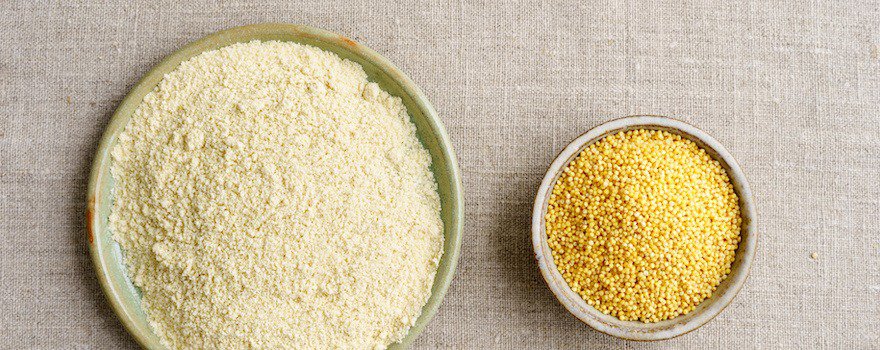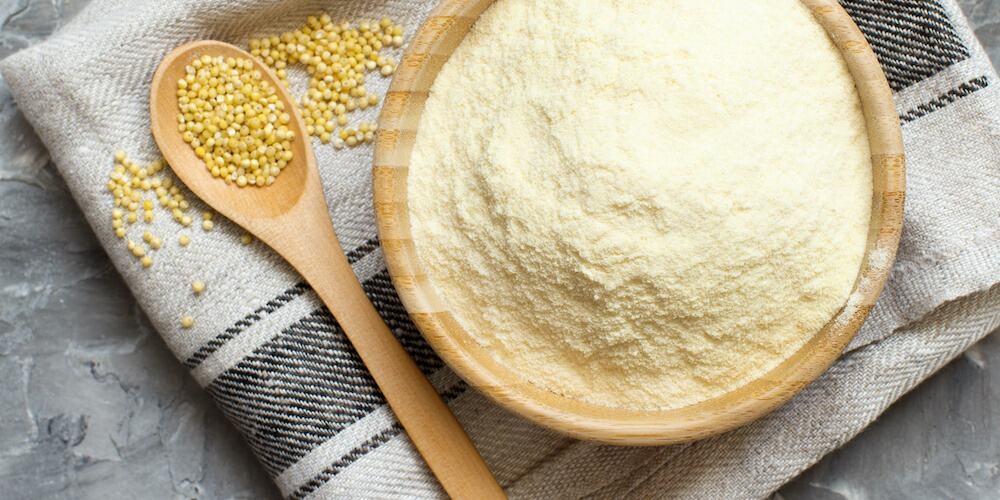The Benefits of Millet Flour
What is Millet Flour?
Millet is an ancient grain originating from Africa and Asia. Like sorghum and oats, it belongs to the grass family.
There are different varieties, but pearl millet (Pennisetum glaucum) is the most commonly used for flour production. The plant produces small, edible yellow seeds.
Once harvested, they are hulled and then ground. This results in an off-white gluten-free flour.
Indeed, similar to buckwheat or hemp flour, it is gluten-free. It is therefore ideal for people with celiac disease. Another interesting benefit is that it is nutritious, rich in plant-based proteins and minerals.
Finally, its nutty flavors and numerous culinary uses are appreciated.
The Virtues of Millet Seeds
With about 11 g per 100 g, these seeds are an excellent source of plant-based proteins. They contain essential amino acids: isoleucine, leucine, methionine, and tryptophan. Thus, they can help compensate for deficiencies associated with a flexitarian, vegetarian, or vegan diet.
They also contain fiber and various minerals and trace elements. They are rich in phosphorus, calcium, iron, and zinc. Finally, they provide a large number of B vitamins as well as vitamins E and K.
Today, millet seeds are recognized for their antioxidant action. As shown in this study, they also improve diabetes and help in weight loss.

How to Choose Millet Flour?
Golden, Brown, or Pearl Millet Flour: Which to Choose?
There are different varieties of millet flour. Thus, we distinguish those made from:
- Brown millet: it is the “wild” form of golden millet. It does not need to be hulled. It is the most digestible and nutritious;
- Golden millet: it needs to be hulled to become digestible. It is therefore less nutritious than brown millet;
- Pearl millet: also called “small millet”, is particularly rich in iron. However, this type of flour is harder to find.
Other Quality Criteria
We recommend choosing organic millet flour. This way, you avoid chemical residue and pesticides in the final product. It should also be 100% natural, without additives and preservatives.
If possible, choose French-origin millet. Although it is still little cultivated, there are producers in the southwest (Poitou-Charentes, Gers…) and the Loire countries. Support local sectors as much as possible.
Also, opt for flour ground with a stone mill. It has a finer texture and retains all its nutrients.
Finally, like sorghum, amaranth, and quinoa, millet is subject to cross-contamination. Thus, the flour may contain traces of gluten. Check this information on the packaging if you need to follow a strict gluten-free diet.
How to Use Millet Flour?
In Cooking
In cooking, it is appreciated for its nutty notes. But its taste is rather pronounced and atypical. It can be softened by combining it with a more neutral flour such as rice or tigernut flour. In this case, it should be added up to 30% in the preparation.
Millet flour allows for numerous sweet recipes: bread, pancakes, waffles, cakes… It is also interesting in savory versions: cakes, vegetarian patties, pizza dough… It provides a texture similar to wheat flour.
Ensure proper storage as it is sensitive to rancidity. Ideally, keep it in the refrigerator after opening. Its shelf life is about 6 months.

Homemade Millet and Tigernut Spread
This recipe reinvents the traditional spread. You can enjoy it on toast… or directly with a spoon!
To make this recipe, have:
- 50 g of millet flour
- 50 g of tigernut flour
- 1 to 2 tablespoons of vegetable oil
- 160 g of honey
In a container, add all the ingredients and mix until you get a smooth and homogeneous mixture.
Pour the mixture into a small glass jar.
Store your spread in the refrigerator and consume it quickly.
Millet and Gluten-Free Waffles
This flour is ideal for preparing gluten-free waffles. It gives them a nutty flavor, a light and crispy texture.
To make this recipe, have:
- 100 g of millet flour
- 100 g of rice flour
- 2 eggs
- 40 g of butter
- 2 teaspoons of sugar
- 1/3 packet of vanilla sugar
- 20 cl of milk
- 10 cl of water
Start by melting the butter in a saucepan over low heat.
In the meantime, pour the flours into a container and mix. Gradually add the milk and mix again until you obtain a homogeneous mixture. Finally, add the egg yolks and set aside the whites.
In your mixture, add the sugars, water, and melted butter. Mix.
Beat your egg whites until stiff and gently fold them into the previous mixture.
Your waffle batter is ready!



